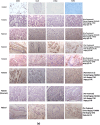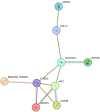Investigating the interaction of ACKR1 and c-Myc in the breast carcinoma tumor microenvironment modulation
- PMID: 40853589
- PMCID: PMC12378275
- DOI: 10.1007/s12672-025-03437-8
Investigating the interaction of ACKR1 and c-Myc in the breast carcinoma tumor microenvironment modulation
Abstract
This study investigates the interplay between the Atypical chemokine receptors (ACKR1)/Decoy receptor for chemokines (DARC) and key molecular markers, including CCL8, c-MYC, ALDH1, and CHEK2, in breast cancer. DARC has been implicated in various aspects of cancer progression, including tumor growth, angiogenesis, and metastasis. By analyzing the expression patterns of these markers in breast cancer tissues, we aim to understand their collective impact on tumor behaviour and identify potential therapeutic targets. Our findings reveal complex interactions between DARC and these molecular markers, suggesting their synergistic roles in promoting or repressing breast cancer progression. Understanding these relationships could lead to developing more effective and personalized therapeutic strategies.
© 2025. The Author(s).
Conflict of interest statement
Declarations. Ethics approval and consent to participate: Participation in the study was voluntary, and verbal and written informed consent was obtained before enrolment. This study was performed in line with the principles of the Declaration of Helsinki. Approval was granted by the Ethics Committee of All India Institute of Medical Sciences (IEC-759/07.10.2022, RP-07/2022). Competing interests: The authors declare no competing interests.
Figures












References
-
- Chaudhuri A, Polyakova J, Zbrzezna V, Williams K, Gulati S, Pogo AO. Cloning of glycoprotein D cDNA, which encodes the major subunit of the Duffy blood group system and the receptor for the Plasmodium vivax malaria parasite. Proc Natl Acad Sci U S A. 1993;90:10793–7. 10.1073/pnas.90.22.10793. - PMC - PubMed
-
- Chaudhuri A, Zbrzezna V, Johnson C, Nichols M, Rubinstein P, Marsh WL, Pogo AO. Purification and characterization of an erythrocyte membrane protein complex carrying Duffy blood group antigenicity. J Biol Chem. 1989;264:13770–4. 10.1016/s0021-9258(18)80067-9. - PubMed
-
- Miller L, Mason S, Dvorak J, McGinniss M, Rothman I. Erythrocyte receptors for (Plasmodium knowlesi) malaria: duffy blood group determinants. Science. 1975;189:561–3. 10.1126/science.1145213. - PubMed
-
- Horuk R, Chitnis C, Darbonne W, Colby T, Rybicki A, Hadley T, Miller L. A receptor for the malarial parasite plasmodium vivax: the erythrocyte chemokine receptor. Science. 1993;261:1182–4. 10.1126/science.7689250. - PubMed
-
- Chaudhuri A, Zbrzezna V, Polyakova J, Pogo AO, Hesselgesser J, Horuk R. Expression of the Duffy antigen in K562 cells: evidence that it is the human erythrocyte chemokine receptor. J Biol Chem. 1994;269:7835–8. 10.1016/s0021-9258(17)37123-5. - PubMed
LinkOut - more resources
Full Text Sources
Miscellaneous
